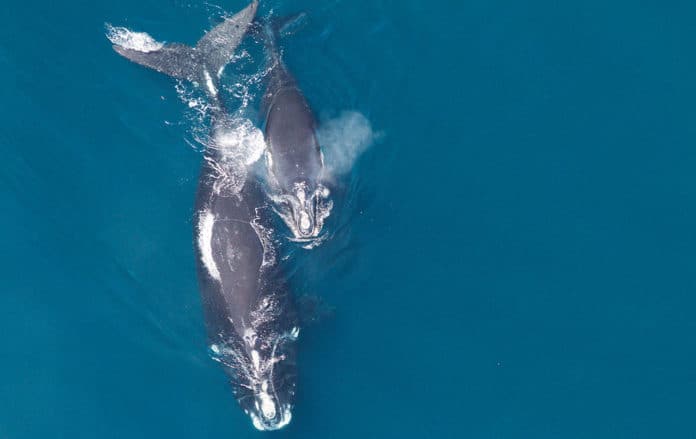Many marine species rely on acoustic signals for social communication, as these signals can propagate efficiently underwater. These long-range communication signals can be intercepted by predators, putting the signaller at an increased risk of predation.
There is evidence for acoustic crypsis from multiple smaller marine mammal species, which produce signals that are less detectable by their marine mammal predators. The same strategy used by new moms to their young calves to avoid attracting predators.
A new study by scientists at Syracuse University, Duke University, and NOAA Fisheries’ Northeast Fisheries Center found that North Atlantic right whales tone down their underwater vocalizations and “whisper” to their young calves to avoid attracting predators.
Right whales typically communicate with one another using a vocalization called an up-call, a rising “whoop” sound that can last two seconds and travels very far. The study uncovers that the new mothers drastically reduce their production of vocalization to communicate to their young through a very quiet, short, grunt-like sound that isn’t audible more than a short distance away.
Susan Parks, University Biology Professor at Syracuse, who led the study, said, “These sounds, previously unknown to scientists, can be thought of almost like a human whisper. They allow the mother and calf to stay in touch with each other without advertising their presence to potential predators in the area.”
For this study, scientists collected the acoustic data by attaching small, noninvasive recording tags via suction cups onto North Atlantic right whales in calving grounds off the coasts of Florida and Georgia. They attached tags to juvenile and pregnant whales found in the area and to mother-calf pairs.
Douglas Nowacek, Repass-Rodgers University Professor of Conservation Technology at Duke University, said, “The mothers significantly reduced the number of higher-amplitude, long-distance communication signals they produced compared to the juvenile and pregnant whales. They also produced these very quiet, whisper-like sounds. This suggests that right whale mother-calf pairs rely on acoustic crypsis — a type of behavior meant to avoid detection — to reduce the risk of eavesdropping by orcas or sharks lurking in nearby murky waters.”
Parks said, “There are still many things we don’t know about their behaviors, and I hope that studies like this will help to improve efforts for their conservation.”
The study was supported by the U.S. Office of Naval Research and the U.S. Fleet Forces Command, which is managed by Naval Facilities Engineering Command Atlantic as part of the U.S. Navy’s Marine Species Monitoring Program.
The study is published in the journal Biology Letters.
